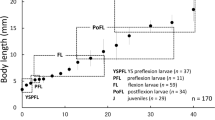Abstract
Morphological development, including that of fins, labyrinth organ, body proportions, and pigmentation, in laboratory-hatched larval and juvenile snakeskin gourami Trichogaster pectoralis is described. Body lengths (BL; mean ± SD) of larvae and juveniles were 2.3 ± 0.1 mm just after hatching (day 0) and 8.2 ± 0.6 mm on day 22, reaching 14.1 ± 2.3 mm on day 48. Aggregate fin ray numbers attained their full complements in juveniles >11.8 mm BL. Preflexion larvae started feeding on day 2 following upper and lower jaw formation, the yolk being completely absorbed by day 12. Subsequently, oblong conical teeth appeared in postflexion larvae >8.2 mm BL (day 16). Melanophores on the body increased with growth, with a large dark spot developing on the lateral midline at the caudal margin of the body in flexion larvae >6.1 mm BL. Subsequently, a broad vertical dark band from the eye to the caudal peduncle developed in postflexion larvae >8.9 mm BL. Proportions of head and pre-anal lengths became constant in postflexion larvae greater than ca. 9–10 mm BL, whereas those of maximum body depth, eye diameter, and snout length failed to stabilize in fish of the size examined in this study. First soft fin ray of the pelvic fin elongated, reaching over 40% BL. The labyrinth organ differentiated in postflexion larvae >7.4 mm BL (day 22). Comparisons of larval and juvenile morphology with another anabantoid species Anabas testudineus were also made, revealing several distinct differences, particularly in the numbers of myomeres and fin rays in the dorsal/anal fins, mouth location and body shape.




Similar content being viewed by others
References
Amornsakun T, Sriwatana W, Promkaew P (2004) Some aspects in early life stage of Siamese gourami, Trichogaster pectoralis (Regan) larvae. Songklanakarin J Sci Technol 26:347–356
Boonsom J (1984) Zooplankton feeding in the fish Trichogaster pectoralis Regan. Hydrobiologia 113:217–221
Burggren WW (1979) Biomodal gas exchange during variation in environmental oxygen and carbon dioxide in the air breathing fish Trichogaster trichopterus. J Exp Biol 82:197–213
Burggren W, Haswell S (1979) Aerial CO2 excretion in the obligate air breathing fish Trichogaster pectoralis: a role for carbonic anhydrase. J Exp Biol 82:215–225
Cole B, Tamaru CS, Bailey R, Brown C (1999) A manual for commercial production of the gourami, Trichogaster trichopterus, a temporary paired spawner. Center for Tropical and Subtropical Aquaculture, Publ No 135, Oahu
Iwata A, Ohnishi N, Kiguchi Y (2003) Habitat use of fishes and fishing activity in plain area of southern Laos. Asian and African Area Studies 3:51–86
Juliano RO, Guerrero III R, Ronquillo I (1989) The introduction of exotic aquatic species in the Philippines. In: De Silva SS (ed) Proceedings of the Workshop on Introduction of Exotic Aquatic Organisms in Asia. Asian Fish Soc Spec Publ No 3, Asian Fisheries Society, Manila, pp 83–90
Kohno H (1998) Early life history features influencing larval survival of cultivated tropical finfish. In: De Silva SS (ed) Tropical mariculture. Academic Press, London, pp 71–111
Kottelat M (2001) Fish of Laos. Ganaratne Offset, Colombo
Kramer DL (1973) Parental behaviour in the blue gourami Trichogaster trichopterus (Pisces, Belontiidae) and its induction during exposure to varying numbers of conspecific eggs. Behavior 47:14–32
Leis JM, Trnski T (1989) The larvae of Indo-Pacific shorefishes. NSW University Press, Kensington
Matayoshi S, Shokita S (1982) Development of air-breathing organ in paradise fish, Macropodus opercularis (Linnaeus) from Okinawa-jima, the Ryukyus. Bull Coll Sci Univ Ryukyus 33:61–67
Matsumoto S, Morioka S, Kumagai S (2001) Development of African catfish Clarias gariepinus larvae during the transitional phase between endogenous and exogenous energy intake. In: Weyl OLF, Weyl MV (eds) Proceedings of the Lake Malawi Fisheries Management Symposium. Department of Fisheries of Malawi, Lilongwe, pp 227–232
Morioka S, Ito S, Kitamura S, Vongvichith B (2009) Growth and morphological development of laboratory-reared larval and juvenile climbing perch Anabas testudineus. Ichthyol Res 56:162–171
Moteki S, Yoseda K, Sahin T, Üstündağ C, Kohno H (2001) Transition from endogenous to exogenous nutritional sources in larval Black Sea turbot Psetta maxima. Fish Sci 67:571–578
Na-Nakorn U, Kamonrat W, Ngamsiri T (2004) Genetic diversity of walking catfish, Clarias macrocephalus, in Thailand and evidence of genetic introgression from introduced farmed C. gariepinus. Aquaculture 240:145–163
Rainboth WJ (1996) Fishes of the Cambodian Mekong. FAO species identification field guide for fishery purposes. FAO, Rome
Rüber L, Britz R, Zardoya R (2006) Molecular phylogenetics and evolutionary diversification of labyrinth fishes (Perciformes: Anabantoidei). Syst Biol 55:374–397
Senanan W, Kapuscinski AR, Na-Nakorn U, Miller LM (2004) Genetic impacts of hybrid catfish farming (Clarias macrocephalus × C. gariepinus) on native catfish populations in central Thailand. Aquaculture 235:167–184
Vidthayanon C (2002) Peat swamp fishes of Thailand. Office of Environmental Policy and Planning, Bangkok
Vromant N, Nam CQ, Ollevier F (2001) Growth performance of Trichogaster pectoralis Regan in intensively cultivated rice fields. Aquacul Res 32:913–921
Welcomme R (1988) International introductions of inland aquatic species. FAO Fisheries Technical Paper 294, Rome
Welcomme RL, Vidthayanon C (2003) The impact of introductions and stocking of exotic species in the Mekong basin and policies for their control. Technical Paper No 9. Mekong River Commission, Phnom Penh
West GJ, Glucksman J (1976) Introduction and distribution of exotic fish in Papua New Guinea. Papua New Guinea Agric J 27:19–48
Acknowledgments
We express our sincere gratitude to K. Sano, Laboratory of Global Fisheries Science, University of Tokyo, and staff of the Aquaculture Improvement and Extension Project of Japan International Cooperation Agency for their kind cooperation on broodstock collection. We are also grateful to L. Khamsivilay and B. Vongvichith, Living Aquatic Resources Research Center, Laos, for their logistical support. Our thanks also go to G. Hardy for his polite and constructive English revision.
Author information
Authors and Affiliations
Corresponding author
About this article
Cite this article
Morioka, S., Ito, S. & Kitamura, S. Growth and morphological development of laboratory-reared larval and juvenile snakeskin gourami Trichogaster pectoralis . Ichthyol Res 57, 24–31 (2010). https://doi.org/10.1007/s10228-009-0118-x
Received:
Revised:
Accepted:
Published:
Issue Date:
DOI: https://doi.org/10.1007/s10228-009-0118-x




